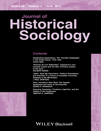Scholars have long documented changes in knowledge regimes and power relations characteristic of state-centric drives to pacify conflicts and govern populations. But the mechanisms through which social conflicts are “made legible” in routine policy processes – as well as the reasons why some ongoing conflicts are pacified and others are persistent – have remained less clear.
